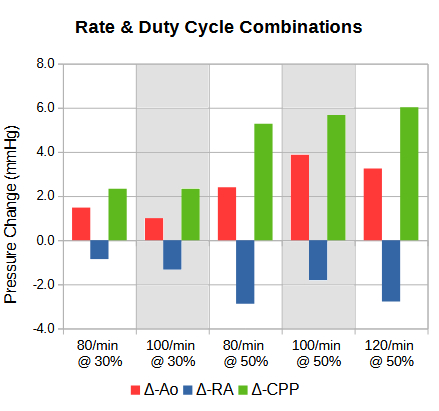Final ID: Su1010
The Effect of Varying Constriction Rate and Duty Cycle Combinations on Hemodynamics in Circumferential Thoracoabdominal Cardiopulmonary Resuscitation
Abstract Body:
Introduction: Circumferential constriction thoracoabdominal CPR (CCTA-CPR) may have enhanced hemodynamics and safety, but its optimal parameters have not been studied. We have found that higher constriction rates and longer duty cycles (DC) are each associated independently with improved indicators of hemodynamics in CCTA-CPR. It is possible that a particular combination of these two CCTR-CPR parameters is optimal.
Hypothesis: In CCTA-CPR, there may be a rate and DC combination that is best-associated with improved indicators of hemodynamics.
Methods: Ventricular fibrillation was induced in female Yorkshire swine (n = 6, ~30 kg). CPR was provided by a prototype pneumatic CCTA-CPR system. CCTA-CPR constriction parameters were alternated in 45-second epochs among rates of 80, 100 and 120 per minute and DCs of 30% and 50%. Aortic (Ao) and right atrial (RA) pressures were measured using micromanometer catheters. Coronary perfusion pressure (CPP) was derived as the difference between the Ao and RA pressures. The change in CPP (Δ-CPP) from the beginning to the end of each treatment epoch was the principal indicator of hemodynamic efficacy. Results from among all experiments were grouped by treatment type and subjected to Analysis of Variance.
Results: Five rate/DC combinations were tested: 80/min at 30% DC, 80/min at 50% DC, 100/min at 30% DC, 100/min at 50% DC, and 120/min at 50% DC. Final Ao pressures for these treatments were 24, 27, 25, 31, and 28 mmHg, respectively. Final RA pressures were 6.7, 6.3, 6.6, 6.9, and 6.9 mmHg. This yields CPPs of 18, 20, 18, 24, and 21 mmHg. The Δ-CPPs were 2.3, 5.3, 2.3, 5.7, and 6.0, respectively. There was a trend toward higher Δ-CPPs with higher rates and with the greater duty cycle (p < 0.10).
Conclusion: There was an association, and possibly interaction, between higher rates of constriction and longer duty cycles with improved indicators of hemodynamics. Overall, a rate of 120/min with a 50% DC appeared optimal. If correct, these findings indicate that previous clinical trials of semi-circumferential automated CPR devices may have read-out incorrectly because of suboptimal device parameters.
Introduction: Circumferential constriction thoracoabdominal CPR (CCTA-CPR) may have enhanced hemodynamics and safety, but its optimal parameters have not been studied. We have found that higher constriction rates and longer duty cycles (DC) are each associated independently with improved indicators of hemodynamics in CCTA-CPR. It is possible that a particular combination of these two CCTR-CPR parameters is optimal.
Hypothesis: In CCTA-CPR, there may be a rate and DC combination that is best-associated with improved indicators of hemodynamics.
Methods: Ventricular fibrillation was induced in female Yorkshire swine (n = 6, ~30 kg). CPR was provided by a prototype pneumatic CCTA-CPR system. CCTA-CPR constriction parameters were alternated in 45-second epochs among rates of 80, 100 and 120 per minute and DCs of 30% and 50%. Aortic (Ao) and right atrial (RA) pressures were measured using micromanometer catheters. Coronary perfusion pressure (CPP) was derived as the difference between the Ao and RA pressures. The change in CPP (Δ-CPP) from the beginning to the end of each treatment epoch was the principal indicator of hemodynamic efficacy. Results from among all experiments were grouped by treatment type and subjected to Analysis of Variance.
Results: Five rate/DC combinations were tested: 80/min at 30% DC, 80/min at 50% DC, 100/min at 30% DC, 100/min at 50% DC, and 120/min at 50% DC. Final Ao pressures for these treatments were 24, 27, 25, 31, and 28 mmHg, respectively. Final RA pressures were 6.7, 6.3, 6.6, 6.9, and 6.9 mmHg. This yields CPPs of 18, 20, 18, 24, and 21 mmHg. The Δ-CPPs were 2.3, 5.3, 2.3, 5.7, and 6.0, respectively. There was a trend toward higher Δ-CPPs with higher rates and with the greater duty cycle (p < 0.10).
Conclusion: There was an association, and possibly interaction, between higher rates of constriction and longer duty cycles with improved indicators of hemodynamics. Overall, a rate of 120/min with a 50% DC appeared optimal. If correct, these findings indicate that previous clinical trials of semi-circumferential automated CPR devices may have read-out incorrectly because of suboptimal device parameters.
More abstracts on this topic:
A Recalled Experience of Death Among Cardiac Arrest Survivors Is Associated with Improved Psychological Outcomes
Goins Imani, Ingram Cambell, Wei Lijing, Gonzales Anelly, He Tun, Moore Sacha, Parnia Sam
A Multicentre Study for Hands Only CPR (HOCPR) training assessment towards building a ‘Nation of Life Savers” in IndiaRavikumar Thanjavur, Sarma Kvs, Ravikumar Thanjavur, Sarkar Manuj, Debnath Dhrubajyoti, Behera Priyamadhaba, Ghate Jayshri, Trikha Divay, Samantaray A, Madhavi K

